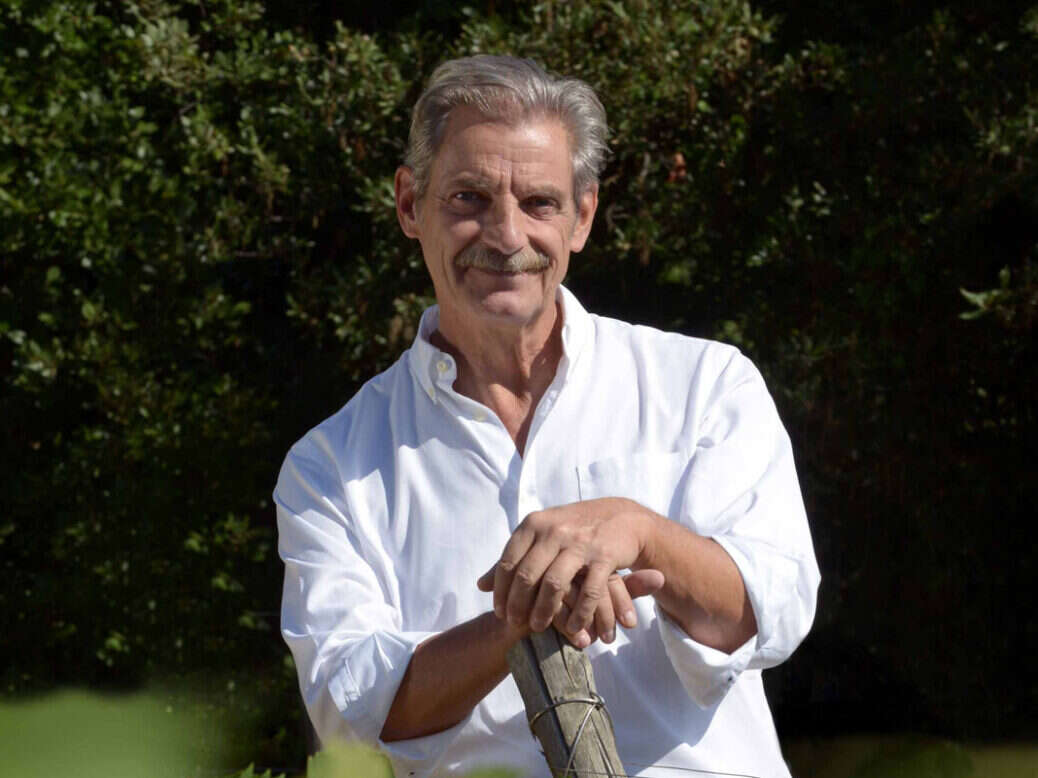
Carlo Ferrini is one of Italy’s most famous winemakers. He has worked from Piedmont to Sicily and back, but as a Florentine by birth, his heart lies in Tuscany. And Sangiovese is his first love. On December 5, 2019, he was in London to show his own wine, a cumulation of his life’s work drawing on rich experiences in the vineyards and wineries to which he has consulted over the past 40 years, including Barone Ricasoli, Fonterutoli, Brancaia, and Talenti.
La grande fortuna
Giodo (a contraction of his parents’ names, Giovanna and Donatello) is a personal project Carlo launched in Montalcino in 2000. After years of research he found what he regards as the perfect site, between Sant’Angelo in Colle and Sant’Antimo, and had the great fortune of piecing together his own estate of 6ha (15 acres)—a considerable extension in the precious world of Brunello.
Prior to becoming a consultant, he was technical director of the Chianti Classico Consorzio where he spearheaded the Chianti Classico 2000 Project: A 16-year scheme which aimed to upgrade the Chianti Classico zone’s Sangiovese vineyards with better clonal material by replanting existing and historically low-density vineyards at much higher densities. Expressing more than once his profound love of Tuscany’s noble grape, Carlo said, “[It] holds no secrets for me.”. So, when the time came to plant his own estate, Carlo selected his favorite few clones from the research project—all low-vigor biotypes that produce loose clusters with very tiny berries—none of which is available on the market.
Pursuit of elegance
Carlo’s first bottled vintage of Brunello di Montalcino was 2009, and another six have followed, garnering enthusiastic reviews from peers and critics. Yet he wishes to keep a low profile, so as not to compete with his all-star clients. The Carlo Ferrini style, and philosophy, he says, is “the search of elegance,” preferring to harvest two days too early rather than two days too late. He recalled a treasured memory of tasting 1990 Château Margaux at a restaurant in Italy in 1993, when he was astounded at the elegance at such an early stage of the wine’s development. A turning point that set him on the pursuit of elegance ever since.
A second love in Sicily
Giodo is a Sangiovese story. But in his pursuit of elegance, Carlo claims he fell in love for a second time, with Etna and its Nerello Mascalese. This, he points out, is where one can really find minerality in the wine, thanks to the black, pumice-rich volcanic soils. Alberelli di Giodo, now on its second vintage, comes from eight to nine individual plots that make up less than one hectare (2.47acres) of ungrafted, 80- to100-year-old vines. With elevations around 3,100ft (950m) that stretch beyond the Etna DOC limits, his wines are labeled Sicilia DOC.
The Wines
Giodo Brunello di Montalcino DOCG
From Sangiovese planted in 2002 at 6,600 vines per hectare and1,000ft (300m) above sea levelin medium-textured, gravel-rich soil; fermentated in steel and concrete vats, matured approximately 30 months in 500- and 700-liter oak casks, then 18 months in bottle.
Giodo Brunello di Montalcino DOCG 2009
3,000 bottles produced
Brilliant garnet and brick hue. Complex nose of warm leather, cedar, tobacco, and earth. Bright acidity all the way through, with tight, slightly grippy and dry tannins but with an overall soft texture on the finish.
Giodo Brunello di Montalcino DOCG 2010
5,000 bottles produced
Seamless, smooth, and rounded on the palate. The tannins are silky, with a gentle tug at the end. Subtle layers of dark chocolate, mocha, caramel infused with the fruit. Very enticing.
Giodo Brunello di Montalcino DOCG 2011
6,000 bottles produced
Aromas of mushroom, forest floor on the sniff, recalling aged Pinot Noir. Lively morello cherry and earthy notes come through on the palate. Slightly drying, chalky tannins and a long finish.
Giodo Brunello di Montalcino DOCG 2012
6,500 bottles produced
Muscular and energetic, with firm tannins, rich texture, and full body. A thoroughbred galloping across the palate. Elegant and powerful.
Giodo Brunello di Montalcino DOCG 2013
8,000 bottles produced
Lifted, ripe, dark-cherry nose, perhaps a hint of VA? Lovely balanced structure, with fresh acidity and fine tannins. Reverberating intensity gives it a long finish.
Giodo Brunello di Montalcino DOCG 2014
A terrible vintage in which only 2,500 bottles were produced, but Carlo was particularly proud of the results.
For the first time in the flight, slight traces of oak (vanilla and spice notes) on the nose. Quite linear, with drying tannins but sufficient berry-fruit concentration to round it out.
Giodo Brunello di Montalcino DOCG 2015 (barrel sample?)
10,000 bottles produced
Opulent and velvety. Bountiful red fruit with cashmere tannins and freshness. Truly elegant.
Giodo Rosso Toscana
From vines planted in 2002, at 6,600 vines per hectare and 1,000ft (300m) above sea level, in medium-textured, gravel-rich soil; fermented in steel and concrete vats, matured approximately 12 months in 500- and 2,500-liter oak casks.
Giodo Rosso Toscana IGT 2015
6,000 bottles produced
Luscious and juicy. Very generous fruit with soft structure underneath. Extremely pleasant and fun.
Giodo Rosso Toscana IGT 2016
6,000 bottles produced
Rich and rounded, with a subtle toffee and spice depth to complement the red-cherry and earth flavors. Very smooth, balanced, and long.
Giodo Rosso Toscana IGT 2017
8,000 bottles produced
A touch of VA here, with floral and red-berry notes. Rather acidic and astringent, lacking the depth of previous vintages.
Alberelli di Giodo Sicilia DOC
Nerello Mascalese 100%, from 80- to 100-year-old vines, planted at 5,000 vines per hectare and 3,100ft (950m) above sea level, volcanic soil; fermented in steel tanks, matured approximately 12 months in 500- and 700-liter oak casks.
Alberelli di Giodo Sicilia DOC 2016
6,000 bottles produced
Quite muscular and powerful, with drying tannins and fresh acidity. Intense, complex, and long across the palate.
Alberelli di Giodo Sicilia DOC 2017
7,200 bottles produced
Rich, warm, and concentrated. Vivid red-berry fruit, with slightly dry, grippy tannins.






